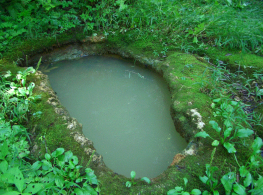Loading...
Please wait while we load your content...
Find the Best Hot Springs in Gifu.
Please wait while we load your content...
The general term for substances precipitated from hot spring components is called "onsenka." Furthermore, onsenka is classified into sulfur onsenka, travertine, silica onsenka, iron onsenka, sulfate onsenka, etc., depending on its constituent components.
Among the hot spring components, those mainly precipitated and deposited as calcium carbonate are called travertine. In hot springs with high calcium content, travertine is easily formed, causing calcium carbonate scale (travertine) to develop inside pipes or attaching miniature terraced field-like scales around bathtubs.
Such travertine can form not only on the edges of pipes and bathtubs but also sometimes create large natural formations outdoors.
In places where hot springs with high calcium content naturally gush out, travertine can form a tower-like elevation called a "fountain tower" at the gushing site or a dome-shaped travertine called a "travertine dome" on the slopes near the gushing site. These natural hot spring phenomena are very rare and academically valuable, so many are designated as special natural monuments or natural monuments of the country. Examples include the travertine dome of Geto Onsen in Iwate Prefecture (nationally designated special natural monument), the fountain tower of Iwama Onsen in Ishikawa Prefecture (nationally designated special natural monument), and the fountain hill of Yumata Onsen in Nagano Prefecture (nationally designated natural monument).
 |
 |
| Travertine dome designated as a special natural monument | Fountain designated as a natural monument |
However, there is actually a large-scale travertine dome formed by naturally gushing hot springs in Gifu Prefecture, which is not well known.
Just before entering the hot spring town of Nigorigo Onsen in Osakacho, Gero City, there was a prefectural nature house until a few years ago. If you descend to the bottom of the Hyoe Valley from that area, you will reach a large waterfall called Zaimoku Falls in the Hyoe Valley. On the gentle slope on the left side along the road approaching the Hyoe Valley, there is a large-scale travertine dome (photo).
The size of the travertine dome is about 30 meters wide at the end, and the length from the top of the dome to the end is approximately 20 meters. It is one of the largest natural onsenka domes in Japan. The surface of the dome has a terraced field-like structure (rimstone). Although it is called travertine, it consists of a soft brown type of travertine called tufa on the surface.
Near the top of the travertine dome, there is a naturally gushing spring source as shown in the photo, and the hot spring water flowing from here has continued to precipitate its components, forming a large-scale travertine dome.
 |
 |
| Large-scale travertine dome of Nigorigo Onsen | Natural gushing hot spring that formed the travertine dome |
Currently, the surface of the travertine dome is covered with green moss, making it difficult to notice that it is a deposit of hot spring precipitates unless you look closely. Also, because the deposits are soft, walking on them would cause damage, so protective measures are urgently needed.